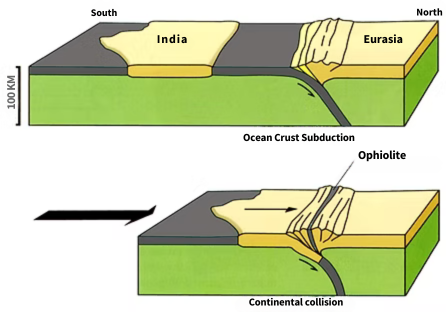In conversation with the old man Ophiolite
- Kanchi Dave
- Jul 12
- 3 min read
Updated: Jul 22

They call me Ophiolite. Funny name, I know. Comes from the Greek word for “snake stone,” thanks to my greenish, scaly look. There’s a lot hidden in that name. I’ve lived a life that most rocks can only dream of.
"I wasn’t always here, nestled in the cold winds of Ladakh’s high mountains. No, I was born in fire, on the seafloor of a long-lost ocean called the Tethys. "

It was the era of the mighty dinosaurs. You humans call it the Mesozoic(fig1). The ocean above me teemed with life, ammonites spiraling through the water, giant marine reptiles gliding past, coral reefs glowing in the shallows. And deep beneath it all, I came into being.
I remember the moment vividly: it was the early Cretaceous(fig1), and I was born at a mid-ocean ridge( fig2) in the Tethyan Ocean. Through the crack where two tectonic plates pulled apart, magma surged up from the mantle and met the cold ocean water, I exhaled! rich gaseous plumes hissing from my newborn skin. That breath marked the start of my life as a patch of oceanic crust(fig2) on this restless Earth.

My outer skin cooled quickly into pillow basalts, smooth and bulbous, like lava sleeping bags. Beneath that, my body formed tangled veins of magma called sheeted dykes. Deeper still, I solidified into gabbro, tough and coarse, formed as magma cooled slowly in the depths. At my very core is Peridotite, green, dense, cooled straight from the Earth’s mantle.

For millions of years, I drifted peacefully along the seafloor with the rest of my brethren. Our path was guided by the great laws of plate tectonics. We moved in silence, unnoticed, toward our inevitable end. You see, an oceanic crust like me begins life at an mid ocean ridge and usually ends at a subduction zone (fig3), pulled beneath a continent, melted back into the same mantle from which we came.
"Most of my kind don’t live more than 180 million years. And honestly, I didn’t expect to either. But fate had other plans."
About 50 million years ago, the Indian Plate, young, fiery, and full of energy, came hurtling

northward like a bull on a rampage. It smashed into the Eurasian Plate with the force of a thousand earthquakes, crushing the Tethys Ocean between them and birthing the Himalayas (fig4). And me? I was caught in the chaos.
Instead of being subducted and recycled like the rest, I was scraped off crushed, twisted, and lifted skyward. I went from sea floor to sky! Scraped off the sinking plate and plastered onto the mountains like a badge of ancient glory. An extremely rare event.
Today, I rest high in the Himalayas, my pillow lavas peeking through mountain passes, my peridotite glinting green under the sun. Waiting for erosion to take its course so I might one day make it back to the mantle. You might pass me by on a trek or while driving along a national highway, thinking I’m just another rock.
But if you stop and listen, I’ll tell you:
I’ve seen oceans rise and vanish.
I’ve felt the planet’s source of fire right beneath me.
I’ve survived fire, water, and continental collisions.
"So next time you're in Ladakh, and you see an oddly green, scaly rock on the roadside… say hello."
You just might be meeting a piece of the ocean floor that made it to the roof of the world.

— Yours in Deep Time,
Old Man Ophiolite
Bukdang Ophiolite, Nubra Valley, Ladakh, India
Note: Complete ophiolites sequences are very rare and are often the aftermath of violent tectonic collisions. They are found on tectonic plate boundaries. In the Indian Himalayas, the most notable complete ophiolites include:
Nidar ophiolite, Nidar Village, Ladakh
Spongtang ophiolite, Zanskar Valley, Ladakh
Shergol ophiolite, Kargil, Ladakh
Bukdang ophiolite, Nubra Valley, Ladakh
References: Lone, Ihsan Ullah, et al. "Recognition of Shyok ophiolites of NW Ladakh Trans-Himalaya as a Geoheritage: Importance to Himalayan Orogeny and remnant of Tethyan oceanic lithosphere." Geoheritage 15.1 (2023): 3.



Comments